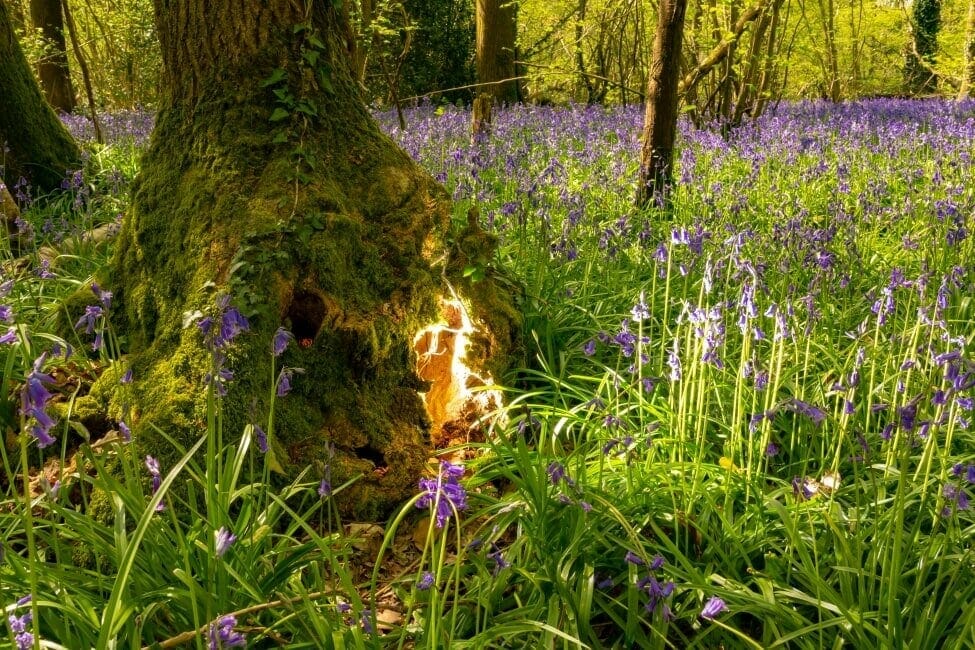Bluebell Flowers and Their Symbolic Meanings
Bluebells (Hyacinthoides non-scripta) are a truly enchanting perennial. These delicate blossoms are commonly found carpeting forest floors, sprouting from containers, and charming home gardens across Europe and North America. In the language of flowers, bluebells carried a variety of symbolic meanings, such as humility, gratitude, constancy, and everlasting love. The flowers are also rich in folklore and mythology, with tales dating back to medieval times linking spring bluebells to witchcraft, fairies, and goblins!

Etymology
Hyacinthoides non-scripta gets its name, “bluebells” from the appearance of its flowers. Growing from a bulb, the bluebell plant sprouts several linear leaves from the ground and a central spire (about 20 inches in height).
The bluebell, common bluebell, English bluebell, or wild hyacinth is scientifically classified as a member of the Hyacinthoides genus in the sub-family Scilloideae under the Asparagaceae family.
The Swedish botanist Carl Linnaeus first described the Hyacinthoides non-scripta in his work, Species Plantarum, which was published in 1753. He designated it “non-scripta” which means unlettered or unrecorded, to distinguish it from the classical hyacinth.
The common bluebell has held many botanical names throughout the years. In 1797, an English botanist argued that nutans (nodding) was more suitable than non-scripta. Thus, the name Hyacinthoides nutans was born.
Color Symbolism

Bluebell flowers range in color from white to gray to pale blue, lilac, and pink to a deep cobalt. In general, bluebell flowers are understood to symbolize gratitude, humility, everlasting love, and constancy.
More specifically, lilac or purple bluebells represent gratitude, white bluebells symbolize purity and spirituality, blue-colored bluebells represent humility and constancy, and pink is the perfect choice for conveying feelings of everlasting love.
Bluebells and Fairies

Having grown for centuries in the land of fairies and goblins, bluebells (also called fairy flowers) are steeped in mythology. Many tales weave dark fairy magic with bluebell woods, legends, curses, and bad luck.
Some believe that fairies use bluebells to enchant and trap humans. If you pick a bluebell, the fairies might lead you astray, and you will become lost forever. If you hear a bluebell ring, it’s been said that a bad fairy will visit, and you or someone close to you will perish soon after.
Bluebells and Witches
In Scotland, bluebells are referred to as harebells because it was believed that witches would transform themselves into hares and then hide in fields of bluebells.
Uses in Ancient Times
Bluebells also had practical uses in ancient times. Their bulbs were sometimes used as a starch substitute for stiffening ruffs (the elaborate collars worn in Elizabethan and Jacobean England), and their adhesive properties were utilized in bookbinding.
Bluebells in Art and Literature

In addition to their place in folklore and legends, bluebells also hold a spotlight in the popular art and literature of Britain. For example, in her poem “The Bluebell,” Emily Bronte describes the beauty of a bluebell wood, the absence of the flowers’ color in the winter, and how their appearance in spring makes her feel homesick.
The beauty of bluebells has likewise inspired many English artists to capture their allure on canvas. In several paintings, the artist Jack Wiggins has forever preserved the charm of sunlight-dappled bluebell meadows that make admirers of his art long for the warmth of spring.
The Victorian Language of Flowers
In the language of flowers and traditional flower symbolism, bluebells represent much more virtuous ideals, such as humility, gratitude, constancy, and everlasting love. These humble meanings are likely attributed to the look of bluebell blossoms, which seem to bow before onlookers.
Bluebell Tattoos
In tattoo art, bluebells are usually chosen as a symbol of gratitude or everlasting love. This is especially true when the flower is inked along with someone’s name.
Suitable Gifting Occasions
Since bluebells are considered to be wildflowers, they aren’t often the “star of the show” in most bouquets. Instead, their pretty blooms are incorporated to add texture, surprising pops of color, and a bit of delicateness to mixed floral arrangements and seasonal springtime designs. Bouquets featuring bluebells have a rustic, whimsical appeal and look beautiful wrapped in twine or tied with a satin ribbon.
Bluebells are often one of the first flowers to bloom abundantly in springtime, making them the perfect choice for celebrating any spring occasion: birthdays, anniversaries, Easter, Mother’s Day, and just because. If you have them growing in your yard and you’re not afraid of fairies, pick a bunch, tie them with a ribbon, and give them to a friend to lift their spirits with the fresh fragrance of spring renewal and rebirth.
When gifting bluebells, you can also use them to convey a floral message with the language of flowers. Deliver a bouquet of pink bluebells to show your everlasting love or give them to a close friend to show how much you appreciate their presence in your life.
Bluebells are also one of the birth month flowers for April. So, in addition to daisies and sweet peas, a bouquet of bluebells is a wonderful way to celebrate a baby’s birth in April or your best friend’s April birthday.
Carpet Your Garden in Blue
These magical, delicate blooms of blue have enchanted forest wanderers, botanists, and home gardeners for centuries. Now that you know how to cultivate a garden of bluebells at home, you can appreciate their beauty each spring while chasing the fairies away.
Further reading: Discover 100 amazing types of purple flowers.
Andrew is the Editorial Director at Petal Republic. He holds a BSc degree in Plant Sciences and has trained professionally at leading floristry schools in London and Paris. In amongst overseeing a global editorial team, Andrew's a passionate content creator around all things flowers, floral design, gardening, and houseplants.
